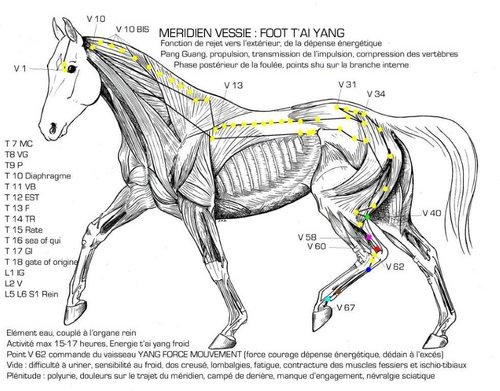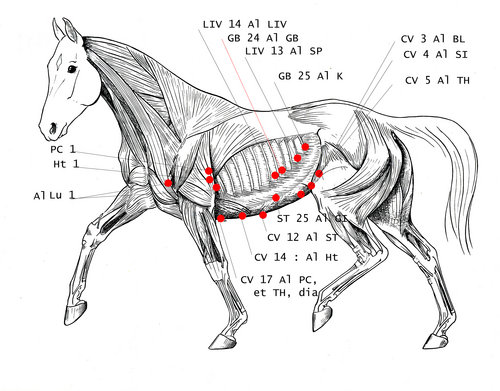MY DEFINITION OF ACUPUNCTUREAcupuncture is an ancient Chinese medicine, used initially by a few million people around the world, and indicated in horses for more than three thousand years.
The tch’i (chi) regarding critical, universal, inherent strength in all matters, whether at the atomic scale or the universe ... "The living should not be understood as a subject driven by energy. It is the energy that has guided the field itself energy, vital to the phenomenon. Life is indeed a simple continuous transformation. Birth and death are only changes in the universal energy. We crossed a great river of material that comes from the outside world and returns. During its passage, this area sells energy to the tissue they need. The sense of the man near the Earth: Chinese is open to the world around him, from macrocosm to microcosm, and over the centuries has been able to organize his observations method. Each ideogram is built from very explicit primitive symbols , modified over the transcripts and then simplified by Mao. Translate Tch’i by "energy" is certainly very reductive, especially far from their reality and far too esoteric for our Western minds. The tch’i, energy, universal principle, can be understood simply by analogy to the operation of a combustion engine, energy to be used, is a mixture of gasoline (rice, yin) and oxygen (steam, yang). This mixture is provided in part by the fuel tank (stomach) and the air filter (lung). With the orders, gas (heart) and wealth (neurovegetative systems, TR, MC) is injected into the pistons (muscles) a balanced explosive mix (yin yang) and effects a way forward. Too much gasoline (yin) and the engine becomes dirty and bad (atheroma), too much oxygen (yang) and the engine is running too fast and too hot (inflammation). Meridians : son of silk, an invisible under current that works like the man in the field clearing the land, irrigating their crops (different parts of the body) with the two mobile entities that are vital energy (wind, tch’i) and blood. Most of the characters have been translated by adapting to our Western mind, thus simplifying, removing a lot of subtlety and even more meaning. Each meridian is fueling an internal organ, which can be full (yin, zang) or hollow (yang, fu, entrails), which control and whose name it bears; the meridian follows a line on the body surface , relating the body to its extremities. The meridians are well described in humans, often with overlapping nerve routes around the organs at least, and transmit patients pain sensations. It is a reasonable to assume its existence in animals. The meridians are associated with the concept of movement they provide: the yang meridians are those of the extension and outward (abduction) of the members
The meridian has a specific pathology (internal organ symptoms and symptoms of belonging or relating to any of the route traveled) due to excess (fullness) or inadequate (empty) of one or the other two vital principles blood (sueh) and energy (tch’i) as well as blocking their movement. When disease in excess, we must first treat the "trunk" of the meridian, ie on the member and then its "branches" on the head or trunk, termination of this meridian. In contrast, with a deficiency illness, you must first treat the branches (moxa), and then the trunk. In serious conditions, devoid of yin meridians, it is appropriate to use the drugs! Finally, the meridians are associated with energy level (Taiyang ...) and grouped in pairs yin-yang connected to one of five elements or movements of traditional Chinese medicine.
By principle, localized pain is a local excess of energy that must be dispersed so that the energy dissipates. An acupuncturist will use a needle, an osteopath will manipulate the area listening carefully to the change of posture induced by the pain caused by pressure on the acupuncture point for some, or trigger point for the other, reflex points, nociceptive pain with names linked to their discoverers ... (Head) Depending on the diagnosis and especially the experience of the acupuncturist, various points will be punctured or heated, either with moxa (mugwort) or directly with a lighter. Whether with needles or by manipulating the local pain will disappear almost instantly. If this is not the case, the operator must review his diagnosis and treatment. This is the usual mode of osteopathy: manipulate, control, manipulate, and control if restrictions or pain persist. |

